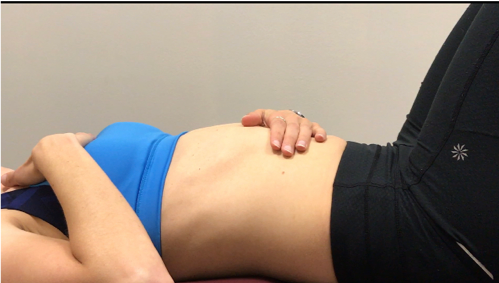“Breath is the link between mind and body.” – Dan Brule
“If you can’t breathe in a position, you don’t own that position. You can’t survive in that position.” – Gray Cook
WHEN THE DIAPHRAGM ISN’T WORKING FOR YOU
There are many reasons we don’t breathe properly. Poor posture, stress, trauma, and lack of stability are a few reasons. Several things can happen as a result:
1. We use our accessory breathing muscles:
Take the time to go into the position of lying on your back with one hand on your belly and one hand on your upper chest. Breathe in deep. Do you feel your chest rise into the hand on your upper chest? What’s happening here is that you are using accessory muscles. These include muscles between your ribs and muscles in your neck. The act of getting air into the lungs in this case is not passive, as it is when the diaphragm expands. It is active. As you might guess, if you continue to use these muscles, they can get fatigued and eventually shorten. This elevates your rib cage and tightens your neck. Shoulder and neck pain with stress anyone? This is why. Stressed breathing is shallow and active instead of deep and passive.
2. We tighten the diaphragm around important structures:
I cannot stress enough about how important it is for the diaphragm to be mobile and functional because…anatomy. The diaphragm attaches to everything! Ok, not everything, but a lot. It attaches to the sternum via the xyphoid process, the ribs, the spine, the fascia of a major back muscle, and the hip flexors. Think of what that could mean for breathing and moving and recruiting the right muscles. Literally, the diaphragm could be a potential source of any injury if it effects your core movement in a way that is detrimental down the chain.
Just as important, if not more, is what passes through the diaphragm.
- The aorta – blood flow to the entirety of your lower half.
- The vena cava – blood flow from the entirety of your lower half back to your heart.
- The esophagus and its sphincter – passage of food into your stomach and what keeps it there!
- The autonomic nervous system – think “rest/digest” and “flight/fight.”
This is huge! If your diaphragm is tight at rest or is relatively tight when you are using it to stabilize, it can have an impact on all the things those major structures are supposed to do. If we reduce restriction and use the diaphragm properly we could effectively:
- Reduce blood pressure (autonomic nervous system and decreased strain on vessels)
- Decrease anxiety (autonomic nervous system)
- Improve digestion (autonomic nervous system and decreased strain on esophagus)
- Improve sleep (autonomic nervous system)
- Improve recovery (autonomic nervous system)
- Decrease reflux (decreased strain on esophagus/stomach)
- Improve food intake during performance (decreased strain on esophagus/stomach)
- Increase oxygen intake (functional breathing)
- Decrease symptoms of exercise induced asthma (functional breathing)
WHAT CAN YOU DO TO BREATHE BETTER?
I have attached a helpful link to more information about diaphragmatic breathing and how to make improvements. Your health and performance will thank you!
Watch the video here

